Abstract
Garvin Heights Park in southeastern Minnesota, USA, is a 12 ha mosaic of bluff prairie, oak savanna, and oak–hickory woodland co-owned by the City of Winona and Winona State University, with a 40+ year history of encroachment by non-native woody invasives, especially buckthorn (Rhamnus cathartica) and honeysuckles (Lonicera spp.). Habitat restoration was initiated in the early 1990s, but management gaps and a seedbank of invasives compromised initial efforts. More consistent and sustainable restoration activities since 2016 have included cutting and chemical treatment of invasives, managed goat browsing, targeted reseeding and plug planting with native species, and more regular prescribed fires. Throughout the restoration process, we assessed changes in buckthorn densities in response to various management practices, assessed the restored savanna tree community, and documented the presence of blooming plants across all park habitats. Manual clearing of woody invasives and repeated goat browsing significantly reduced buckthorn and honeysuckle abundance in prairies and savannas. Park plant communities responded to the combination of management strategies with reduced densities of woody invasives and expanding diversity (currently >220 species present) of forbs and grasses, including a large and growing population of state-threatened Great Indian Plantain (Arnoglossum reniforme). Prescribed fires have benefitted prairies but have done little to improve savanna plant communities, due largely to excessive tree canopy coverage causing a lack of burnable fuels (i.e., dry forbs and grasses). Improved partnerships between landowners and dedicated volunteers are working to expand restoration efforts to include other portions of the park and adjacent woodlands.
1. Introduction
Prairie, savanna, and woodland habitats throughout the world have suffered from encroachment by woody invasive plants [1,2,3,4]. Encroachment can occur because of invasion of habitats by aggressive native and non-native species [1,4,5,6] or by reduced frequencies of natural disturbances (e.g., fire, grazing) that would otherwise suppress young woody plants [3,7,8,9,10,11]. Conversely, overgrazing also can encourage woody encroachment by suppressing competing herbaceous growth and reducing fire frequency [12,13]. Woody encroachment can negatively impact ecosystems by reducing plant diversity; altering light, water, and nutrient dynamics; and degrading habitat quality [14,15,16,17,18,19,20,21].
In addition to the problems posed by encroachment from woody invasives, prairies and savannas also are threatened by expanding agriculture, livestock production, silviculture, urbanization, and other human activities, with habitat losses in some regions exceeding 95% [22,23]. Such dramatic losses have led to a growing need to protect, rehabilitate, or restore the remaining natural prairie and savanna habitats and the often-rare species found within them [24,25,26,27,28,29]. The science of prairie and savanna restoration continues to gain traction [2,30], bringing new methodology, technology, and modeling [7,8,12,31,32,33,34,35,36,37,38,39,40,41,42] to an already strong foundational knowledge of the ecological structure and functioning of these disturbance-dependent habitats [3,43,44,45,46].
The Midwestern USA contains a diversity of tallgrass prairie and oak savanna remnants. In addition to a few remaining large tracts that span hundreds to thousands of hectares in Kansas, Nebraska, Illinois, and Iowa [47,48,49,50], much smaller systems occupy the ridgetops and steep slopes within the Driftless Area, a region missed by the most recent glaciation that spans portions of southwestern Wisconsin, northwestern Illinois, northeastern Iowa, and southeastern Minnesota [51,52]. The topography of this region, dominated by high bluffs separated by valleys that all lead to the Mississippi River, provides a mosaic of isolated ridges with small-scale blufftop savannas and bluff prairies on steep slopes with southerly or southwesterly aspects [28,51,52,53]. These savannas and prairies are found on extremely shallow soils that are both water- and nitrogen-limited and overlie limestone and sandstone bedrock [54].
The small size and isolated nature of Driftless Area prairies and savannas make them especially prone to encroachment by woody invasives [28,51]. Both non-native (buckthorn, Rhamnus cathartica; honeysuckle, Lonicera spp.) and native (e.g., Eastern Red Cedar, Juniperus virginiana; aspen, Populus spp.; Slippery Elm, Ulmus rubra; American Hazelnut, Corylus americana; brambles, Rubus spp.) woody species can be problematic in prairie and savanna habitats [6,52,53,55]. Encroachment can lead to habitat shrinkage, division, or even loss [51] unless management activities are undertaken to suppress the spread of undesirable woody species in these habitats [28,52,53,55,56,57].
Restoring woody-encroached savanna and prairie remnants requires frequent prescribed fires to open the canopy, suppress shrubs and saplings, and promote grass and forb abundance and diversity. Fire is often paired with mechanical tree thinning to more rapidly and selectively reduce canopy cover. However, a sudden decrease in canopy cover can favor woody midstory species [58], with subsequent fires failing to control shrub and sapling species with resprouting capabilities [59]. Therefore, there has been increased interest in goat, cattle, and bison browsing/grazing as a supplemental restoration approach. Recent studies show that goats and cattle can effectively reduce shrub density in woody-encroached ecosystems, at least in the short-term [6,21]. There is also evidence that using multiple restoration tools (i.e., thinning, burning, herbicides, and grazing) is more effective than each approach on its own [60,61,62].
In this paper, we evaluate the decades of effort spent managing woody invasive encroachment in a city park in the Driftless Area of southeastern Minnesota, USA. Non-native shrubs invaded the site’s savannas and bluff prairies before 1980, and active management began during the early 1990s. We hypothesized that habitat restoration efforts such as aggressive cut-stump treatment, prescribed burns, goat browsing, and repeated seeding efforts would produce measurable reductions in woody invasives and improvements in native plant communities within the park’s savanna and bluff prairie habitats.
2. Study Area
Garvin Heights Park (N 44°2′ 3.45″, W 91° 39′ 6.00″) is a largely undeveloped 12 ha park located in the City of Winona in southeastern Minnesota, USA (Figure 1). It encompasses a mosaic of dry bedrock bluff prairie (Figure 2A), dry hill oak savanna (Figure 2B), and southern dry-mesic oak–hickory woodland [54] located on a blufftop ridge overlooking the city and the Mississippi River floodplain. Soils in the park are comprised of an excessively drained Brodale–Bellechester complex, a rocky and loamy colluvium (flaggy fine sandy loam) derived from dolomite and located on steep slopes (>30%) [63]. Annual air temperatures and annual precipitation average 9.4 °C and 87 cm, respectively [64]. Woody encroachment after the 1950s greatly reduced the amount of prairie and savanna habitat within the park (Figure 2C,D). The only development within the park is an access road leading to a small parking lot, a paved walkway leading to two paved overlooks (small east-facing overlook and a larger [main], north-facing overlook with informational signage) (Figure 3A,C), and a maintained trail connecting the overlook to the base of the bluff >150 m below the overlook (Figure 3B). The main overlook is bordered on the southwest by dry bluff prairie with bare rock outcroppings and on the north and east by steeply sloped oak–hickory woodlands (Figure 1). The prairie is separated into two parcels (i.e., upper prairie, 0.17 ha; lower prairie, 0.245 ha) by a savanna (hereafter referred to as small savanna, 0.26 ha), and additional savanna habitat (hereafter large savanna, 1.66 ha) extends to the south along the walkway, parking lot, and access road.
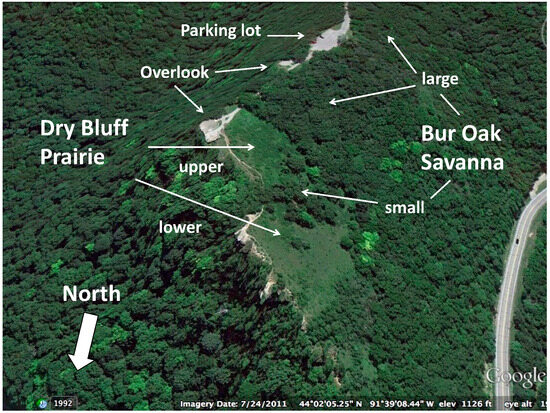
Figure 1.
Aerial view of Garvin Heights Park, Winona, Minnesota, USA, indicating the main prairie and savanna habitats.
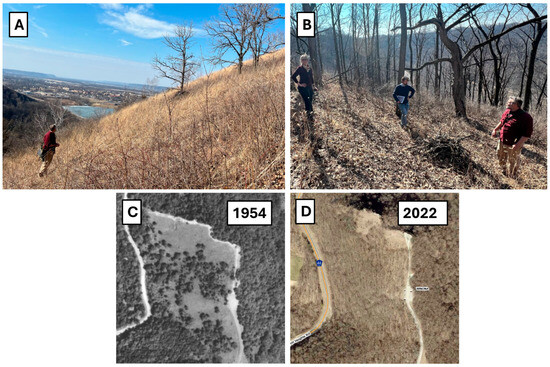
Figure 2.
Dry bluff prairie (lower prairie, (A)) and bur oak savanna (large savanna, (B)) at Garvin Heights Park, along with aerial photos (north is to the top of the photos) of the park from 1954 (C) and 2022 (D) illustrating the loss of prairie and savanna habitat to woody encroachment.
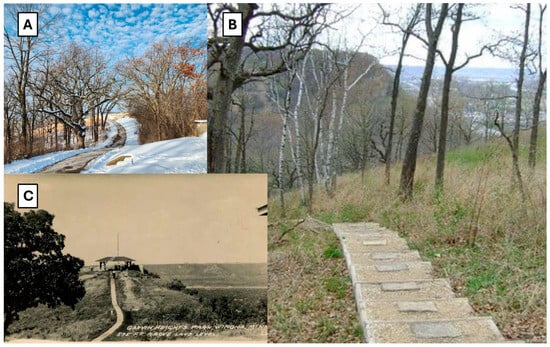
Figure 3.
Infrastructure at Garvin Heights Park: paved path leading to the main overlook during winter (A) with large savanna on the left—note the dense growth of woody invasives on the woodland edge to the right; hiking path descending through the large savanna to the base of the bluff (B); historical photograph (mid-1900s) of the path to the main overlook with its original roofed pavilion (C).
Prior to becoming a park, Garvin Heights lands likely were used for some combination of timber production and livestock grazing during the late 1800s and early 1900s. Early photographs (Figure 3C) depict the area as being much more open with fewer trees [65], and wire-reinforced concrete fenceposts and other fence lines throughout the present-day park suggest a mosaic of former livestock pastures. On lands too steep to grow crops, early farmers used fire to discourage tree growth and encourage grasses for grazing by cattle, horses, sheep, and goats [66].
A portion of the land on which the park is located originally was gifted to Winona Teacher’s College in 1922 by local resident H.C. Garvin. Additional lands have been added to the park at various times, more than doubling the size of the original park. Garvin Heights Park was first opened to the public in 1922. Initial development included an access road, parking lot, and walkway to the main north-facing overlook, all located along the ridge crest (Figure 3A,C). Infrastructure in the park was unpaved except for the concrete used for the main overlook, a second east-facing overlook, two sets of steps along the walkway, and picnic table platforms scattered in the savanna along the walkway. Both overlooks originally were protected by simple roofed pavilions (Figure 3C). The trail descending the bluff also had several hundred cut-stone steps (locally quarried dolomite), mostly on the steep top section (Figure 3B). In 1939, construction of a log cabin or stone lodge on the college property was proposed to serve both as a meeting place and as a caretaker residence [67]. However, the building was never constructed, and the park has remained without any enclosed structure throughout its existence.
Today, the park is jointly owned and maintained by Winona State University (WSU) and the City of Winona and attracts ~50,000 visitors annually [57]. Since its inception, parklands at Garvin Heights largely have remained in their natural state. There is no written record of any types of management activities (i.e., prescribed burns, tree harvest or thinning, weed control) within the park relating to any of the prairie, savanna, or woodland parcels. Only narrow mowed borders of turfgrasses were maintained along and around the access road, walkways, and the parking lot. As visitor numbers rose over time, increasing maintenance issues led to asphalt paving of the access road, parking lot, and walkway to the main overlook and installation of concrete curb and gutter around the parking lot perimeter.
Common native plants within the park include trees such as bur oak (Quercus macrocarpa), Paper Birch (Betula papyrifera), Northern Red Oak (Quercus rubra), and Shagbark Hickory (Carya ovata); shrubs such as Lead Plant (Amorpha canescens), Common Ninebark (Phytocarpus opulifolius), and Prairie Wild Rose (Rosa arkansana); grasses such as Big Bluestem (Andropogon gerardii), Indian Grass (Sorghastrum nutans), Side-oats Grama (Bouteloua curtipendula), and Bottlebrush Grass (Hystrix patula); and forbs such as Stiff Goldenrod (Solidago rigida), Yellow Giant Hyssop (Agastache nepeoides), Tall Boneset (Eupatorium maculatum), Brown-eyed Susan (Rudbeckia triloba), and Sweet Joe Pye Weed (Eupatorium pupureum).
Non-native plants arrived irregularly at Garvin Heights at least since the 1960s, based on herbarium specimens contained in the Winona County/Garvin Heights collection in the Joseph P. Emanuel Herbarium at WSU. Invasive non-native shrubs/trees (e.g., buckthorn, honeysuckles) also arrived and spread within the park prior to the 1980s (Figure 4A) [55]. Ultimately, it was these woody invasives that led to the need for vegetation management within the park, as buckthorn completely took over the upper prairie at the main overlook and adjacent savannas and formed an impenetrable wall of thick vegetation along both sides of the access road, walkway, and completely around the parking lot.
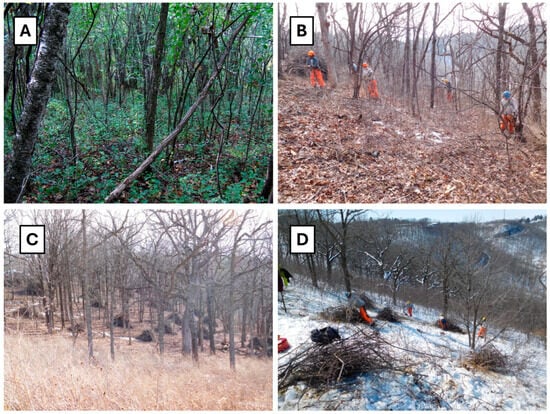
Figure 4.
Photos of savanna restoration at Garvin Heights Park, Winona, Minnesota, USA: large savanna habitat pre-restoration (A), note sapling and larger buckthorn, plus a groundcover of seedling buckthorn; Conservation Corps crew members cutting and treating buckthorn on the large savanna, late winter 2016 (B); cleared large savanna with buckthorn brush piles as viewed from the upper prairie (C); Conservation Corps crew members cutting and treating buckthorn saplings on the small savanna, April 2018 (D).
3. Methods
3.1. Woody Invasive Clearing
The first management efforts were directed toward buckthorn and honeysuckle on the upper prairie and the adjacent savanna to the west and downslope in 1992. Woody invasives were cut, and cut stumps were chemically treated with the herbicides triclopyr and glyphosate. Cut brush was allowed to dry before being burned on site. No work was performed on the lower prairie due to the absence of woody invasives. Vegetation maintenance continued on the upper prairie and adjacent lower savanna for several years, including periodic cutting and treating of woody invasives. In addition, native Black Walnut (Juglans nigra) saplings that appeared in the prairie periodically (likely the offspring of a mature walnut tree near the prairie edge) were removed.
In 2004 and 2005, rehabilitation work continued on that portion (0.25 ha) of the large savanna adjacent to the upper prairie and lying on both sides of the walking trail that descends the bluff (i.e., trailside section). During both years, buckthorn was cut and stump-treated and cut brush was later burned on site.
Buckthorn and honeysuckle densities within the trailside section of the large savanna were monitored during September or October every other year from 2006 to 2014. Woody invasive counts were made within randomly selected plots (1 m × 2 m) in both restored (n = 30 plots) and non-restored (n = 30 plots) each year.
Beginning in 2016, WSU partnered with the City of Winona and the Conservation Corps of Minnesota and Iowa (CCMI) to revisit and expand vegetation management efforts at Garvin Heights Park. The focus again was on buckthorn and honeysuckle control, with activities encompassing both upper and lower prairies, the small savanna, and the entirety of the large savanna.
During late winter 2016, the CCMI conducted a one-day chain saw safety-and-use training session at Garvin Heights Park for 35 of their new employees (Figure 4B), using as their training site a portion (0.48 ha) of the large savanna that previously had experienced no buckthorn or honeysuckle removal plus the trailside section (0.25 ha) worked on 10 years earlier (total project area = 0.73 ha). A larger, more southerly portion (0.93 ha) of the large savanna was not utilized during training and remained uncleared of woody invasives (Figure 4A). Buckthorn and honeysuckle of all sizes were cut and stem-treated to prevent regrowth. In addition, standing dead timber, a few small-diameter bur oaks, and several live non-oak trees (e.g., American Basswood [Tilia americana], Black Walnut, Eastern Cottonwood [Populus deltoides]) not typically found in local savannas were removed. All cut timber was piled to dry (Figure 4C) before burning the following winter (January 2017) when snow covered the ground and fire had minimal impact on the soil seedbank. All timber piles were measured to estimate the total volume of woody invasives removed.
During fall 2016, all standing live trees remaining in the “restored” section of the large savanna were counted, identified, and measured (nearest cm diameter at breast height, DBH). The count was facilitated by subdividing the large savanna into six plots (each 20 m × 40 m). Densities, frequencies, and coverages (based on basal areas) were determined for each species, and these were then used to calculate species-specific importance values (importance = relative density + relative frequency + relative coverage).
Also during fall 2016, canopy coverage was estimated within the large savanna by establishing five non-intersecting transects (each 100 m in length) and taking photographs vertically into the canopy at irregularly spaced intervals along each transect. Photographs (n = 47) were projected onto a grid (15 × 25 square units) and all units containing mostly (>75%) leaves or branches were counted and expressed as a percentage of the total number of units examined to estimate percent canopy coverage within the cleared portion of the large savanna.
In early April 2018, a CCMI crew cleared woody invasives from the lower prairie and the small savanna. Eastern Red Cedar (Juniperus virginiana) was cut at several locations throughout the prairie and around several bedrock outcrops. Because of aesthetic concerns of some local citizens, a few cedars were left uncut around an undeveloped overlook. On the small savanna, goats (see below) had failed to browse on a dense (9 stems/m2) stand of sapling buckthorn over three separate browsing events (Figure 5A). Consequently, CCMI personnel cut and stump-treated all buckthorn throughout the small savanna (Figure 4D).
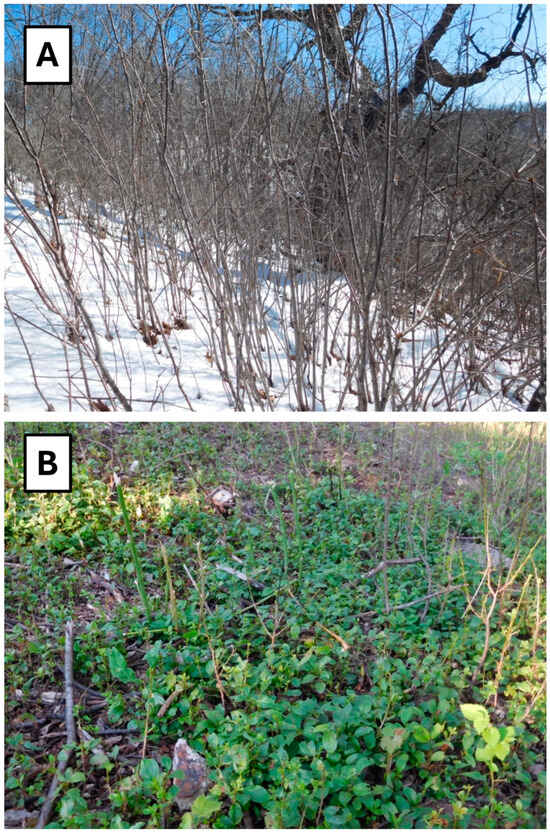
Figure 5.
Buckthorn on savanna habitats at Garvin Heights Park: dense stand of sapling buckthorn that resisted goat browsing on the small savanna (A); dense groundcover of buckthorn seedlings remaining on the large savanna after a period of goat browsing (B). Note the heavy browsing damage on larger plants.
3.2. Goat Browsing
To address the continuing issue of buckthorn and honeysuckle in both savanna and prairie habitats at Garvin Heights Park, a commercial goat browsing company (Diversity Landworks, LLC, Freeburg, MN, USA) was contracted to subject the entireties of both the large and small savannas and the upper prairie to repeated browsing using goats (Figure 6). The lower prairie continued to be relatively free of these two woody invasives, so browsing efforts were focused elsewhere.
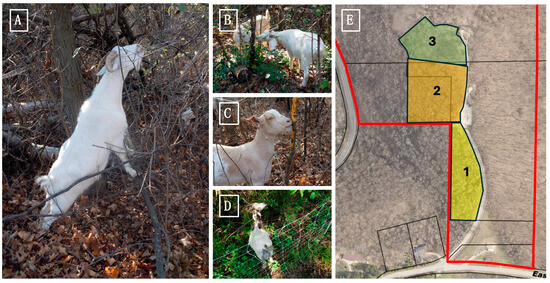
Figure 6.
Goats browsing on buckthorn at Garvin Heights Park: stretching to reach tall shoots and branches (A); feeding on stump resprouts after top-killing larger buckthorn by bark-stripping (B); bark-stripping a tall buckthorn sapling (C); eating buckthorn leaves and branches near electrified paddock fencing (D). Aerial view of Garvin Heights Park (north is to the top of the photo) showing locations of the three paddocks (1, 2, 3) used for goat browsing (E). Red lines indicate park boundaries.
For efficient browsing without interfering with access to the trail descending the bluff, goats were fenced in three separate paddocks: one enclosing only the uncleared southerly portion of the large savanna, another including most of the remainder of the large savanna with the northern edge bordering the descending trail, and the final one enclosing the upper prairie, small savanna, and the small portion of the large savanna north of the descending trail (Figure 6E). Double fencing was used along higher-traffic public areas to better separate people and goats. One paddock was browsed at a time, with goats moved sequentially among paddocks during each browsing episode. Time spent in each paddock varied (3 to 11 days) based on the number of goats used (35 to 70 head), the amount of browse available in each paddock, and the professional judgement of browsing company personnel. Goats were provided with water and nutritional supplements in each paddock and were monitored daily by browsing company personnel. Goats were used in five separate browsing events: one in November 2016, two in 2017 (June, October), one in June 2018, and the last in June 2019. Timing of browsing events was based on herd availability and browse abundance. Goats typically were on-site for a total of three weeks (range 19 to 23 days) during each browsing event.
To assess the effectiveness of goats only in suppressing buckthorn (no clearing or chemical treatment, no use of fire), we conducted density counts of buckthorn using both belt transects (for buckthorn 6–59 mm basal diameter; n = 13 transects each year) and small plots (first-year seedlings and second-year plants; n = 30–40 one m2 plots each year) in the non-cleared portion of the large savanna two years prior to the onset of browsing and after one and five browsing episodes.
We also conducted density counts of buckthorn seedlings in the portion of the large savanna that was subjected to (in order) clearing and chemical treatment of buckthorn, repeated browsing by goats, and repeated prescribed fires. Counts (n = 25–45 one m2 plots each year) were conducted during October 2016, 2018, and 2020, with the first count in 2016 occurring shortly after the first browsing episode.
3.3. Native Species Reseeding and Planting
In 2002, a partnership including Winona State University, the City of Winona, and the Minnesota Department of Natural Resources was established to work on a 5-year park restoration and upkeep program [57]. While some native grasses and forbs on the upper prairie rebounded after invasive removal, supplemental seeding was undertaken during fall 2004 to restore previously existing species reduced by, or lost to, woody encroachment (13 species of forbs, 2 species of grasses; 473 seeds/m2; Table 1).

Table 1.
Native forbs and grasses seeded to the upper prairie at Garvin Heights Park during fall 2004 after removal of woody invasives.
With buckthorn abundance reduced, seeds of native savanna forbs, shrubs, and grasses were purchased from a local source and planted at both the trailside section of the large Garvin Heights savanna (30 species of forbs, 1 species of shrub, 4 species of grasses; 1409 seeds/m2; Table 2) plus the remainder of the large savanna still with buckthorn present (49 species of forbs, 3 species of shrubs, 9 species of grasses; 785 seeds/m2; Table 2) in preparation for future work.

Table 2.
Plant species seeded or planted as plugs into savanna habitats at Garvin Heights Park, 2004–2005 and 2018–2020.
Beginning in fall 2018, a series of efforts were used to restore the native plant community on the large savanna at Garvin Heights Park. When a heavy early October 2018 snowfall occurred, the cleared portion of the large savanna was re-seeded with a seed mix (18.3 kg/ha) that contained local ecotypes of 24 species of forbs, six species of grasses, two species of shrubs/vines, and three species of sedges specifically selected and mixed for the site by a local seed producer (Table 2). Seeds were spread by hand over the snow, covering all portions of the cleared portion of the savanna. A second, smaller application (10.1 kg/ha) of the same seed mix used in October 2018 was spread on the large savanna in March 2020. In June 2019, >350 plugs and/or bare roots of grasses (three species) and forbs (seven species; Table 2) were planted into the cleared portion of the large savanna to further jumpstart the recovery of a native savanna community after many years of canopy closure by buckthorn, honeysuckle, and overabundant small bur oaks.
Throughout the 2019 growing season (April–November), plants were surveyed on all habitats (prairies, savannas, woodlands) at Garvin Heights Park to develop a contemporary plant list for the site. On a week-by-week basis, the presence of various plant species was recorded and flowering periods were noted. Photo documentation was made for each species observed, and a comprehensive bloom calendar was constructed for Garvin Heights Park based on the year’s observations.
We used the 2019 plant list generated for Garvin Heights Park to make two comparisons to aid in evaluating the site’s plant community restoration. First, we compared the 2019 list to the list of species (mostly collected from the 1960s through the 1990s) in the Garvin Heights Collection in the Joseph P. Emanuel Herbarium at Winona State University to assess what proportion of the mostly pre-buckthorn plant community were present in 2019 after contemporary restoration efforts. Second, we compared the 2019 species list to the lists of plants seeded or plugged during the various restoration efforts (mostly since 2004) to assess the success rate of the seeding and planting efforts.
3.4. Prescribed Burns
Prescribed burns have been used at Garvin Heights Park irregularly in conjunction with clearing, goat browsing, and reseeding to restore the site’s prairies and savannas. Following initial removal of woody invasives in the early 1990s and the reappearance of native grasses and forbs, a prescribed spring burn was conducted on the entire upper prairie and small savanna in 1994. A second prescribed burn was conducted during late fall 2006 to suppress woody invasives and to maintain a good balance of native forbs and grasses. Spot burns of the restored savanna section were attempted in late spring of both 2007 and 2008 but were ineffective due to lack of fuel [57].
In May 2017, a prescribed burn was attempted on the cleared section of the large savanna to kill seedling buckthorn that grew after the previous year’s clearing event. The burn was very poor and spotty due to lack of fuel to carry flames, and few buckthorn were damaged or killed.
During fall 2018, a prescribed burn was conducted on both savannas by a CCMI crew. On the small savanna, dried buckthorn brush from the April clearing was burned along with dry grasses and forbs from the 2018 growing season. On the large savanna, a prescribed burn again was attempted with limited burnable fuel. A few days later, a CCMI crew returned to the large savanna with propane-fueled weed torches to burn seedling buckthorn (Figure 5B). Two large plots within the savanna were not burned with weed torches to assess the direct impact of a prescribed burn versus weed torch use on above-ground survival of seedling buckthorn. Within one week after weed-torching, we made counts of surviving buckthorn in 40 randomly selected one m2 plots within the weed-torched area along with counts in 45 similar plots in the non-weed-torched sections.
3.5. Treatment Summary
Overall, four different treatment strategies were applied to the four main prairie and savanna habitats at Garvin Heights Park. However, the four strategies were not applied equally to the four habitats (Table 3). Only the upper prairie had all four strategies applied to it in its entirety. In contrast, the lower prairie was neither seeded nor browsed, and only a few select woody invasive plants were cut and treated. A portion of the large savanna was not cleared or seeded, whereas the small savanna was subjected to all treatments but remained unseeded.

Table 3.
Use of various plant restoration community restoration treatments on each of four prairie and savanna habitats in Garvin Heights Park. Yes = treatment applied. No = treatment not applied. In part = treatment applied only to a portion of the habitat.
4. Results
4.1. Woody Invasive Clearing
Cutting and stem-treatment of woody invasives in the large savanna during 2004/2005 appeared to have slight suppressive effects on the densities of buckthorn relative to densities in non-restored areas, although large plot-to-plot variability in densities inhibited detection of significant differences between restored and non-restored areas except during seven and nine years after treatments (yearly t tests: p values > 0.05 except in 2012 and 2014; Figure 7). In contrast, honeysuckle densities were similar in restored and non-restored areas of the savanna throughout the years of observation (t test p values all > 0.05; Figure 7), although honeysuckle was much less abundant than buckthorn. During 2016, brush (comprised mostly of woody invasives) in the restored portion of the large savanna was gathered into 47 piles after cutting and then dried for mid-winter burning (Figure 4C). Brush piles (mean ± SD, 7.6 ± 4.7 m3, range = 0.6–26.6 m3) had a combined volume estimated as 355 m3 (or 487 m3/ha).
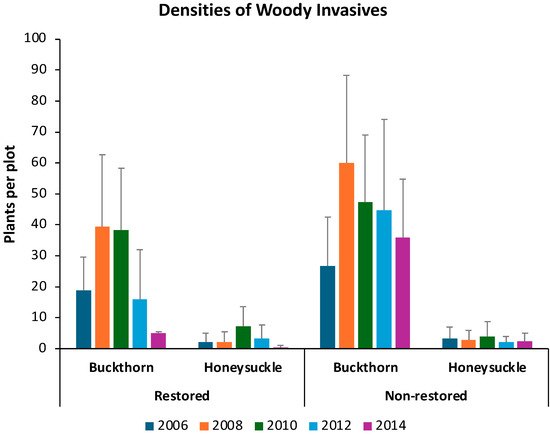
Figure 7.
Densities (mean ± SD; number per 2 m2 plots; n = 30 plots per year per section) of buckthorn and honeysuckle on restored and non-restored sections of the large savanna at Garvin Heights Park one to nine years after cutting and stump treatment of woody invasives in 2004 and 2005.
After removal of woody invasives and minor thinning in a portion of the large savanna, a 2016 survey of trees (n = 243; 13 total species represented) within the stand indicated that bur oaks comprised 72% of all trees present and exhibited an overall importance value greater than all other species combined (Figure 8A). However, a majority (56%) of those bur oaks were small (<20 cm in DBH) (Figure 8B). Mean canopy coverage within the cleared portion of the large savanna was measured at 78% (95% confidence interval = 72 to 84%, n = 47) during late summer 2016. Additional limited thinning since 2016 has not altered the canopy of this savanna section (September 2024 canopy coverage [mean ± SD]: 79 ± 12%, n = 15).
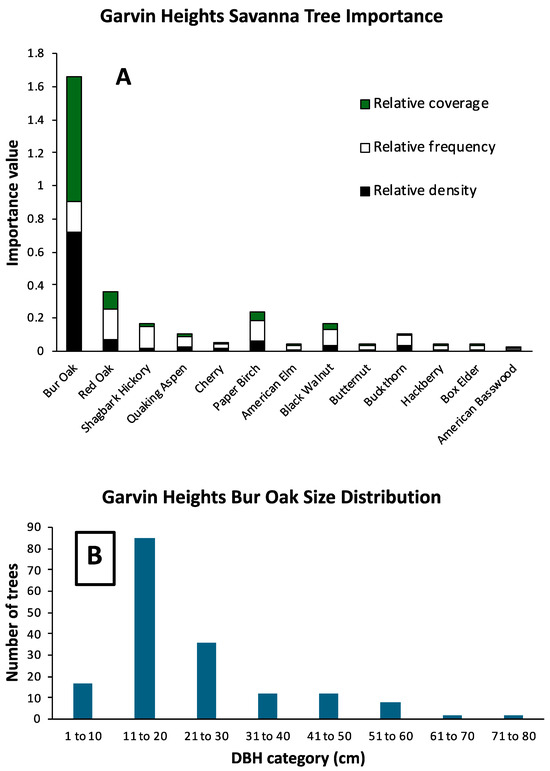
Figure 8.
Importance values of tree species remaining on the large savanna in Garvin Heights Park after woody invasive removal (n = 242 trees), fall 2016 (A) and the size distribution (DBH = diameter at breast height) of the 174 bur oak trees in that savanna (B).
4.2. Goat Browsing
Using only goats as a tool to suppress buckthorn proved moderately successful for two of the three age categories of buckthorn examined. Seedling buckthorn densities were reduced significantly (by half or more; Kruskal–Wallis p < 0.001) after a single goat browsing than before (Figure 9), although densities remained unchanged after subsequent browsings. Densities of 2nd-year buckthorn were unaffected by browsing (Figure 9; Kruskal–Wallis p = 0.74). Finally, buckthorn sapling (stem diameter = 6–59 mm) densities were reduced significantly (Kruskal–Wallis p < 0.001) by goat browsing, declining by 80% relative to pre-browsing counts after one browsing and by 98% after five browsings (Figure 9).
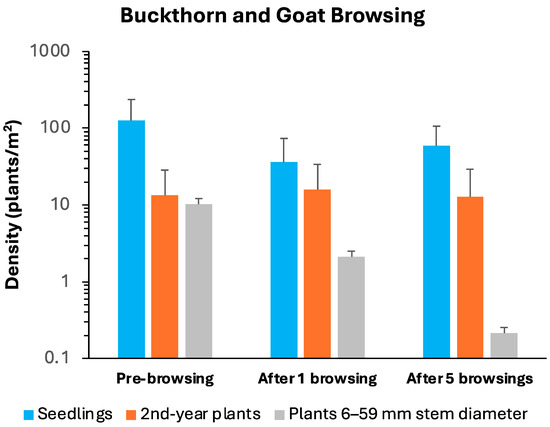
Figure 9.
Densities (mean ± SD) of three buckthorn size groups on the non-restored portion of the large savanna in Garvin Heights Park before and after exposure to goat browsing.
In the portion of the large savanna where goat browsing was used in conjunction with buckthorn clearing, chemical treatment, and prescribed fire, seedling buckthorn density gradually declined from 2016 to 2020, reduced by >65% across that period (Figure 10).

Figure 10.
Declining buckthorn seedling densities (mean + 1 SD; numbers on bars are sample sizes) on the restored portion of the large savanna at Garvin Height Park after cutting and treating of buckthorn and honeysuckle in late winter 2016. Goats browsed buckthorn in this habitat five times between October 2016 and June 2019.
4.3. Herbarium Collection, Re-Seeding, Plug Planting, and Plant Inventories
The Joseph P. Emanuel Herbarium at Winona State University contained a total of 99 species within its designated Garvin Heights Collection. The collection list included trees (16 species), shrubs (6, including 2 species of honeysuckles but no buckthorn), forbs (71), grasses (2), vines (2), and ferns (2) comprised of both native and non-native species. Of these 99 species, 26 of them were documented as present during 2019 plant surveys.
In total, 92 plant species were either seeded or planted in Garvin Heights Park during the years 2004, 2005, 2018, and 2020 (Table 2). Only 16 of those 92 species appeared on the pre-restoration herbarium list.
During the 2019 growing season, 222 plant species were tallied as present at Garvin Heights. Photos were taken of every plant species that bloomed (Figure 11), and a final bloom calendar was constructed for Garvin Heights Park based on the year’s observations (Figure 12). Peak bloom diversity (106 species) occurred in August during 2019 (Figure 13).

Figure 11.
Example plants blooming at Garvin Heights Park during August 2019: Nodding Wild Onion (Allium cernuum) (A,B); Rough Blazing Star (Liatris aspera) (C); Earlyleaf Brome (Bromus latiglumis) (D,E); Late Figwort (Scrophularia marilandica) (F).
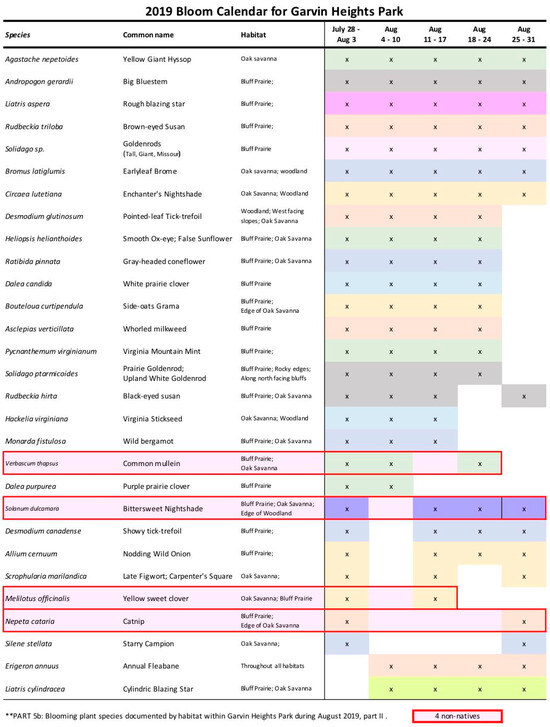
Figure 12.
Portion of the August 2019 bloom calendar for Garvin Heights Park. Other than non-native species outlined in red, colors are used simply to distinguish among species.
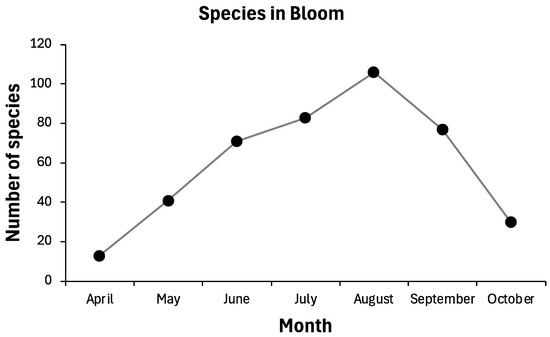
Figure 13.
Numbers of species observed in bloom each month in prairie, savanna, and woodland habitats at Garvin Heights Park during 2019.
Of the 75 plant species seeded into prairie and savanna habitat at Garvin Heights during 2004 and 2005, 55 species (73%) were observed blooming during 2019. Eight additional species seeded in 2018 were observed in bloom in 2019. Overall, 28% of the 222 species documented as blooming in 2019 may have originated from seeding, whereas 72% of species blooming in 2019 could be considered “volunteers” which had no recent (2004 or after) seed application history.
4.4. Prescribed Burn Versus Weed-Torching
Prescribed fire and weed-torching had dramatically differing effects on seedling buckthorn in a Garvin Heights savanna. After a prescribed fire was attempted on the large savanna with limited burnable fuel during late fall 2018, densities of remaining live buckthorn seedlings averaged 120 plants/m2 (SD = 62 plants/m2). By contrast, after weed-torching this same habitat days later, live buckthorn seedling densities were significantly (nearly 90%; t = 11.23, p < 0.0001) lower (13 ± 14 plants/m2) than after the prescribed burn.
5. Discussion
Removal and cut-stump chemical treatment of woody invasives is a labor-intensive but effective method for restoring prairie and savanna habitat remnants [5,68,69,70]. Follow-up treatments often are needed until any invasive seedbank becomes depleted [70]. At Garvin Heights Park, cut-and-treat practices prior to 2016 were implemented mostly on a small scale with limited personnel due to lack of funding. Timely and regular removal of newly sprouted invasives was not always realized due to lack of volunteer workers. Since 2016, grant funding and donated in-kind labor connected to grant funding has allowed for significantly more woody invasive removal over short time intervals, greatly accelerating the pace of restoration and suppression of new invaders.
Prescribed browsing/grazing by goats or other livestock also can be an effective approach to managing woody invasives [6,21,55], especially when used in combination with other management techniques [60,61,62]. As with cut-and-treat practices, prescribed browsing usually requires repeated applications to (1) kill above-ground invasives; (2) remove basal resprouts; and (3) consume plants that develop over time from the seedbank [55]. Goat browsing significantly reduced woody invasive abundance in savanna and prairie habitats in Garvin Heights Park. Buckthorn densities were reduced by 90% by goats cropping the leaves and branches of young plants, girdling stems 20 to 60 mm in diameter, and consuming basal resprouts on top-killed plants [55]. Goats had little to no direct effect on either seedling buckthorn or plants with stems >60 mm in diameter, as neither size group was consumed in any significant proportion. Seedlings were largely ignored by goats because feeding on low-growing plants at ground level is atypical behavior for goats, and the bark of larger buckthorn is unpalatable to goats (K. Johnson, Diversity Landworks, personal communication). However, repeated browsing of goats on sapling plants appeared to result in gradual depletion of the buckthorn seed bank [55]. Goats were able to kill large buckthorn only if trees were first toppled to bring leaves and stems within reach of goats, followed by later repeated browsing on basal resprouts.
Due to the very public nature of the project site, two incidents occurred involving goats and local juvenile humans. In the first incident, the entire herd of goats was driven out of their fenced enclosure and into a nearby field by juveniles shooting at the goats with paintballs. A nearby resident alerted authorities about the escaped goats and browsing company personnel returned them to their paddock unharmed aside from a few paint spots. A few days later, a police patrol discovered that a group of juveniles had captured a goat and had it in their car after park closure for the day. They also were in possession of a paint ball gun, so eventually they were charged with both theft and vandalism. The goat was returned to the paddock unharmed.
Re-seeding and planting of native species on Garvin Heights Park’s prairies and savannas has succeeded in improving the plant community diversity of those habitats. Although the Winona State University herbarium collection list of 99 species is most likely an under-representation of the pre-restoration plant community in the park, the 222 species documented in the park in 2019 is a good indicator of the success of seeding and restoration efforts to date, as this level of species richness is within the range expected for these habitats in North America [71,72,73]. In addition, the fact that over 70% of the species seeded into the park in 2004 and 2005 had become established and were maintaining populations in 2019 further demonstrates restoration success [74,75].
Prescribed fire is one of the most common plant community restoration and management techniques used in North American prairies and savannas [76,77]. Periodic fire is needed in these habitats to 1) maintain an open canopy by suppressing woody vegetation and 2) promote a sustainable balance of forb and grass abundance and diversity [59,62,76,77,78]. In Garvin Heights Park, prescribed fires have proven most useful and successful in prairie habitats, whereas their efficacy in savannas has been fairly limited to date due to insufficient burnable fuels. The unnaturally high canopy coverage of the Garvin Heights savannas produces a ground layer of fallen leaves but little else in the form of dry forbs or grasses, limiting the ability of the fire to carry and produce heat sufficient to kill woody invasives. The significant effect of weed torches on mortality of buckthorn seedlings after plants were first subjected to a prescribed burn indicated that more burnable fuels are needed to produce a fire hot enough to kill buckthorn seedlings.
Recent woody invasive management appears to be benefiting rare species at Garvin Heights. For example, the federally endangered Rusty Patched Bumble Bee (Bombis affinis) [79] was spotted at Garvin Heights Park during August 2021, collecting pollen on blooming Joe Pye Weed. In addition, the state (Minnesota) threatened Great Indian Plantain (Arnoglossum reniforme) [80] has been rapidly expanding in abundance since it was first noticed in 2016. A population survey of plantain on the small savanna and upper prairie in October 2020 revealed the presence of 801 total plantain, including 243 mature flowering plants. A subsequent survey in October 2024, encompassing both upper and lower prairies and large and small savannas, found 2966 total plants, 601 flowering. This population currently is the largest reported in Minnesota and may represent the largest within the species’ range in eastern North America [81].
6. Current and Future Management
Since October 2020, efforts have continued to suppress woody invasives in all prairie and savanna habitats at Garvin Heights Park. Activities have included cutting and treating buckthorn saplings as they appear in the upper and lower prairies, establishing and/or refreshing firebreaks around all savannas and prairies to facilitate prescribed fires, and conducting prescribed burns as needed to kill woody invasive seedlings and maintain a good balance between forbs and grasses. The most recent burns were conducted during April in both 2024 (upper prairie and small savanna) and 2025 (large and small savanna and upper prairie). With each attempt, the burns are achieving more uniform coverage of the burn unit. The 2025 burn covered >95% of the target area due to increased fuel sources and optimal conditions. To better plan future efforts and provide timely control over woody invasives, the City of Winona, the Winona State University Landscape Arboretum, and a local volunteer group SE_MN_Rx_Burn have partnered to develop a vegetation management plan for the park habitats.
Continued management of woody invasives in Garvin Heights Park will follow the protocols and timelines laid out in the soon-to-be-released vegetation management plan. Included in the plan will be a schedule for future prescribed burns on prairie and savanna habitats and recommendations for thinning the canopies in both savannas from their current levels of >75% to lower levels (approximately 25 to 50%) more typical of healthy dry hill oak savanna in this region [37,54,82]. The City of Winona, which has ownership of most of this savanna, explored the possibility of holding a timber sale to open the canopy, but there was no interest in harvest of what were mostly smaller diameter trees of little market value.
Additional restoration efforts within the park are expected to focus on brush removal from the uncleared southerly portion of the large savanna and the adjoining oak–hickory maple–basswood forest. While the uncleared portion of the large savanna was browsed five times by goats from 2016 to 2019, no other vegetation management has occurred there, and that habitat still contains a mid-story of older buckthorn and honeysuckle. Forest habitats have not received any type of vegetation management. The forest interior contains few woody invasives, but edge habitats are covered in dense stands of buckthorn and honeysuckle.
The local community has been encouraged by the positive changes in the park landscape and many area residents have joined in the continuing restoration efforts: cutting woody invasives, clearing firebreaks, burning prairies and savannas, and re-seeding areas as needed. Moving forward, the main goals for the future will be to maintain areas that have been restored while expanding restoration activities into habitats still needing removal and control of woody invasives.
7. Conclusions
Through a combination of clearing and chemical treatment of woody invasives, targeted goat browsing, re-seeding and planting efforts, and prescribed fire, the plant community restoration and management activities spanning 30 years at Garvin Heights Park have been effective in reducing the abundance of woody invasive plants and improving the diversity of forbs, grasses, and other native plants in the park’s remnant bur oak savannas and dry bluff prairies. Clearing and cut-stem treatment eliminated most seed-producing and sapling buckthorn and honeysuckle in prairie and most savanna habitats in the park. Repeated goat browsing over 3 years also killed any buckthorn stump resprouts and new buckthorn saplings as they appeared, gradually depleting the buckthorn seedbank and resulting in reduced buckthorn seedling densities. Re-seeding and planting efforts were successful, with >70% of restored species becoming established. Although canopy coverage (>75%) in savannas is currently higher than desirable for this region, >220 plant species have been documented recently within the park. Prescribed fires have been successful in the park’s prairies, but savanna habitats lacked sufficient burnable fuels to effectively kill off buckthorn seedlings. Although not all efforts were successful, and multi-year time gaps in management activities allowed woody non-natives to re-invade, the managing partners for Garvin Heights Park are encouraged by the restoration progress, especially since 2016.
Author Contributions
N.D.M. and J.H. developed the idea for the paper and N.D.M. and A.M.Y. wrote the first draft. J.H. edited the first draft. N.D.M. secured the most recent funding for restoration efforts and N.D.M., A.M.Y., and J.H. all participated in recent restoration efforts. Restoration efforts have been coordinated through the City of Winona by J.H. All authors have read and agreed to the published version of the manuscript.
Funding
Funding for vegetation management at Garvin Heights Park has come from a variety of sources. These include private donors, the Winona Community Foundation, the Winona State University Foundation, and a grant from Minnesota’s Environment and Natural Resources Trust Fund, as recommended by the Legislative-Citizen Commission on Minnesota Resources. Winona State University also provided funding for a graduate research student to conduct plant surveys and coordinate restoration efforts by citizen volunteers.
Data Availability Statement
Data available from the authors upon reasonable request.
Acknowledgments
We thank the Winona State University Landscape Arboretum, the City of Winona, the Conservation Corps of Minnesota and Iowa, Prairie Moon Nursery, and Diversity Landworks for their contributions toward restoring the plant communities at Garvin Heights Park. We also thank C. Jefferson, P. Simon, R. Walsh, and T. Jacobs for their many hours of work at Garvin Heights.
Conflicts of Interest
The authors declare no competing interests.
References
- Zalba, S.M.; Villamil, C.B. Woody plant invasion in relictual grasslands. Biol. Invasions 2002, 4, 55–72. [Google Scholar] [CrossRef]
- Clewell, A.F.; Aronson, J. Ecological Restoration: Principles, Values, and Structure of an Emerging Profession; Island Press: Washington, DC, USA, 2007. [Google Scholar]
- Wagle, P.; Gowda, P.H. Tallgrass prairie responses to management practices and disturbances: A review. Agronomy 2018, 8, 300. [Google Scholar] [CrossRef]
- Lamb, N.; Havens, K.; Holloway, J.; Steffen, J.F.; Zeldin, J.; Kramer, A.T. Low passive restoration potential following invasive woody species removal in oak woodlands. Restor. Ecol. 2022, 30, e13568. [Google Scholar] [CrossRef]
- Webster, C.R.; Jenkins, M.A.; Jose, S. Invasion biology and control of invasive woody plants in eastern forests. Native Plants J. 2007, 8, 97–106. [Google Scholar] [CrossRef]
- Yantes, A.M.; Solberg, K.L.; Montgomery, R.A. Targeted cattle grazing for shrub control in woody-encroached oak savannas. Restor. Ecol. 2025, 33, e14368. [Google Scholar] [CrossRef]
- Kirkman, L.K.; Coffey, K.L.; Mitchell, R.J.; Moser, E.B. Ground cover recovery patterns and life-history traits: Implications for restoration obstacles and opportunities in a species-rich savanna. J. Ecol. 2004, 92, 409–421. [Google Scholar] [CrossRef]
- Mandle, L.; Bufford, J.L.; Schmidt, I.B.; Daehler, C.C. Woody exotic plant invasions and fire: Reciprocal impacts and consequences for native ecosystems. Biol. Invasions 2011, 13, 1815–1827. [Google Scholar] [CrossRef]
- Foster, J.R.; Shaff, S.E. Forest colonization of Puget lowland grasslands at Fort Lewis, Washington. Northwest Sci. 2003, 77, 283–296. [Google Scholar]
- Dunwiddie, P.W.; Bakker, J.D. The future of restoration and management of prairie-oak ecosystems in the Pacific Northwest. Northwest Sci. 2011, 85, 83–92. [Google Scholar] [CrossRef]
- Buisson, E.; Le Stradic, S.; Silveira, F.A.O.; Durigan, G.; Overbeck, G.E.; Fidelis, A.; Fernandes, G.W.; Bond, W.J.; Hermann, J.-M.; Mahy, G.; et al. Resilience and restoration of tropical and subtropical grasslands, savannas, and grassy woodlands. Biol. Rev. 2019, 94, 590–609. [Google Scholar] [CrossRef]
- Ansley, R.J.; Castellano, M.J. Strategies for savanna restoration in the southern Great Plains: Effects of fire and herbicides. Restor. Ecol. 2006, 14, 420–428. [Google Scholar] [CrossRef]
- Dudley, N.; Eufemia, L.; Fleckenstein, M.; Periago, M.E.; Petersen, I.; Timmers, J.F. Grasslands and savannahs in the UN decade on ecosystem restoration. Restor. Ecol. 2020, 28, 1313–1317. [Google Scholar] [CrossRef]
- Knapp, A.K.; Briggs, J.M.; Collins, S.L.; Archer, S.R.; Bret-Harte, M.S.; Ewers, B.E.; Peters, D.P.; Young, D.R.; Shaver, G.R.; Pendall, E.; et al. Shrub encroachment in North American grasslands: Shifts in growth from dominance rapidly alters control of ecosystem carbon inputs. Glob. Change Biol. 2008, 14, 615–623. [Google Scholar] [CrossRef]
- Ratajczak, Z.; Nippert, J.B.; Collins, S.L. Woody encroachment decreases diversity across North American grasslands and savannas. Ecology 2012, 93, 697–703. [Google Scholar] [CrossRef] [PubMed]
- Stevens, N.; Lehmann, C.E.R.; Murphy, B.P.; Durigan, G. Savanna woody encroachment is widespread across three continents. Glob. Change Biol. 2017, 23, 235–244. [Google Scholar] [CrossRef]
- Abella, S.R.; Menard, K.S.; Schetter, T.A.; Sprow, L.A.; Jaeger, J.F. Rapid and transient changes during 20 years of restoration management in savanna-woodland-prairie habitats threatened by woody plant encroachment. Plant Ecol. 2020, 221, 1201–1217. [Google Scholar] [CrossRef]
- Vander Yacht, A.L.; Keyser, P.D.; Barrioz, S.A.; Kwit, C.; Stambaugh, M.C.; Clatterbuck, W.K.; Simon, D.M. Reversing mesophication effects on understory woody vegetation in mid-southern oak forests. Forest Sci. 2019, 65, 289–303. [Google Scholar] [CrossRef]
- Ratajczak, Z.; Nippert, J.B.; Hartman, J.C.; Ocheltree, T.W. Positive feedbacks amplify rates of woody encroachment in mesic tallgrass prairie. Ecosphere 2011, 2, art121. [Google Scholar] [CrossRef]
- Ratajczak, Z.; Nippert, J.B.; Ocheltree, T.W. Abrupt transition of mesic grassland to shrubland: Evidence for thresholds, alternative attractors, and regime shifts. Ecology 2014, 95, 2633–2645. [Google Scholar] [CrossRef]
- Marchetto, S.; Wolf, T.M.; Larkin, D.J. The effectiveness of using targeted grazing for vegetation management: A meta-analysis. Restor. Ecol. 2021, 29, e13422. [Google Scholar] [CrossRef]
- Nuzzo, V.A. Extent and status of Midwest oak savanna: Presettlement and 1985. Nat. Areas J. 1986, 6, 6–36. [Google Scholar]
- Abella, S.R.; Jaeger, J.F.; Brewer, L.G. Fifteen years of plant community dynamics during a northwest Ohio oak savanna restoration. Mich. Bot. 2004, 43, 117–127. [Google Scholar]
- Odanaka, K.; Gibbs, J.; Turley, N.E.; Isaacs, R.; Brudvig, L.A. Canopy thinning, not agricultural history, determines early responses of wild bees to longleaf pine savanna restoration. Restor. Ecol. 2020, 28, 138–146. [Google Scholar] [CrossRef]
- Hartung, S.C.; Brawn, J.D. Effects of savanna restoration on the foraging ecology of insectivorous songbirds. Condor 2005, 107, 879–888. [Google Scholar] [CrossRef]
- Barrioz, S.; Keyser, P.; Buckley, D.; Buehler, D.; Harper, C. Vegetation and avian response to oak savanna restoration in the mid-south USA. Am. Midl. Nat. 2013, 169, 194–213. [Google Scholar] [CrossRef]
- Brawn, J.D. Effects of restoring oak savannas on bird communities and populations. Conserv. Biol. 2006, 20, 460–469. [Google Scholar] [CrossRef] [PubMed]
- Johanson, C.J.; Schmid, S.A.; Mundahl, N.D. Fire history and woody encroachment influence saxicolous macrolichen community composition on dolomite outcrops in dry bluff prairies of the Minnesota Driftless Area. Prairie Nat. 2024, 56, 56–70. [Google Scholar]
- Panzer, R.; Gnaedinger, K.; Derkovitz, G. The prevalence and status of conservative prairie and sand savanna insects in the Chicago Wilderness Region. Nat. Areas J. 2010, 30, 73–81. [Google Scholar] [CrossRef]
- Greipsson, S. Restoration Ecology; Jones and Bartlett Learning: Sudbury, MA, USA, 2011. [Google Scholar]
- Fill, J.M.; Platt, W.J.; Welch, S.M.; Waldron, J.L.; Mousseau, T.A. Updating models for restoration and management of fiery ecosystems. Forest. Ecol. Manag. 2015, 356, 54–63. [Google Scholar] [CrossRef]
- Blumenthal, D.M.; Jordan, N.R.; Svenson, E.L. Weed control as a rationale for restoration: The example of tallgrass prairie. Conserv. Ecol. 2003, 7, 6. [Google Scholar] [CrossRef]
- Blumenthal, D.M.; Jordan, N.R.; Svenson, E.L. Effects of prairie restoration on weed invasions. Agric. Ecosyst. Environ. 2005, 107, 221–230. [Google Scholar] [CrossRef]
- Trowbridge, C.C.; Stanley, A.; Kaye, T.N.; Dunwiddie, P.W.; Williams, J.L. Long-term effects of prairie restoration on plant community structure and native population dynamics. Restor. Ecol. 2017, 25, 559–568. [Google Scholar] [CrossRef]
- Wilson, S.D.; Pärtel, M. Extirpation or coexistence? Management of a persistent introduced grass in a prairie restoration. Restor. Ecol. 2003, 11, 410–416. [Google Scholar] [CrossRef]
- Grundel, R.; Pavlovic, N.B. Using conservation value to assess land restoration and management alternatives across a degraded oak savanna landscape. J. Appl. Ecol. 2008, 45, 315–324. [Google Scholar] [CrossRef]
- Vander Yacht, A.L.; Barrioz, S.A.; Keyser, P.D.; Harper, C.A.; Buckley, D.S.; Buehler, D.A.; Applegate, R.D. Vegetation response to canopy disturbance and season of burn during oak woodland and savanna restoration in Tennessee. Forest Ecol. Manag. 2017, 390, 187–202. [Google Scholar] [CrossRef]
- Coutinho, A.G.; Alves, M.; Sampaio, A.B.; Schmidt, I.B.; Vieira, D.L.M. Effects of initial functional-group composition on assembly trajectory in savanna restoration. Appl. Veg. Sci. 2019, 22, 61–70. [Google Scholar] [CrossRef]
- Wiederhecker, A.; Ferreira, M.C.; Rodrigues, S.B.; Sampaio, A.B.; Schmidt, I.B.; Ribero, J.F.; Ogata, R.S.; Rodrigues, M.I.; Solva-Coelho, A.C.; Abreu, I.S.; et al. Ten years of direct seeding restoration in the Brazilian savanna: Lessons learned and the way forward. J. Environ. Manag. 2024, 365, 121576. [Google Scholar] [CrossRef]
- Syktus, J.I.; McAlpine, C.A. More than carbon sequestration: Biophysical climate benefits of restored savanna woodlands. Sci. Rep. 2016, 6, 29194. [Google Scholar] [CrossRef]
- Brudvig, L.A.; Asbjornsen, H. Patterns of oak regeneration in a Midwestern savanna restoration experiment. Forest Ecol. Manag. 2008, 255, 3019–3025. [Google Scholar] [CrossRef]
- Dou, P.; Miao, Z.; Wang, J.; Huang, J.; Gao, Q.; Wang, K.; Wang, K. The key to temperate savanna restoration is to increase plant species richness reasonably. Front. Environ. Sci. 2023, 11, 1112779. [Google Scholar] [CrossRef]
- Collins, S.L. Disturbance frequency and community stability in native tallgrass prairie. Am. Nat. 2000, 155, 311–325. [Google Scholar] [CrossRef] [PubMed]
- McPherson, G.R. Ecology and Management of North American Savannas; The University of Arizona Press: Tucson, AZ, USA, 1997. [Google Scholar]
- Jeltsch, F.; Weber, G.E.; Grimm, V. Ecological buffering mechanisms in savannas: A unifying theory of long-term tree-grass coexistence. Plant Ecol. 2000, 161, 161–171. [Google Scholar] [CrossRef]
- Leach, M.K.; Givnish, T.J. Gradients in the composition, structure, and diversity of remnant oak savannas in southern Wisconsin. Ecol. Monogr. 1999, 69, 353–374. [Google Scholar] [CrossRef]
- Heggen, K. Remnant Prairie: A Closer Look at Iowa’s Rarest Landscape; Iowa Natural Heritage Foundation: Des Moines, IA, USA, 2017; Available online: https://www.inhf.org/blog/blog/remnant-prairie-a-closer-look-at-iowas-rarest-landscape/ (accessed on 13 April 2025).
- United States National Park Service. Tallgrass Prairie National Preserve Kansas; United States National Park Service: Strong City, KS, USA, 2025. Available online: https://www.nps.gov/tapr/index.htm (accessed on 13 April 2025).
- United States Forest Service. Midewin National Tallgrass Prairie; United States Forest Service: Wilmington, IL, USA, 2025. Available online: https://www.fs.usda.gov/midewin (accessed on 13 April 2025).
- Johnsgard, P.A. A Guide to the Tallgrass Prairies of Eastern Nebraska and Adjacent States; University of Nebraska: Lincoln, NE, USA, 2007.
- Sarwacinski, M.I.; Berg-Binder, M.C. Relationships between plant community species richness, remnant area, and invasive leafy spurge cover in southeastern Minnesota bluff prairie habitats. Bios 2017, 88, 19–28. [Google Scholar] [CrossRef]
- Brock, T.D.; Brock, K.M. Oak savanna restoration: A case study. In Proceedings of the 19th North American Prairie Conference, Madison, WI, USA, 8–12 August 2004; Egan, D., Harrington, J.A., Eds.; University of Wisconsin-Madison: Madison, WI, USA, 2006; pp. 178–183. [Google Scholar]
- Pierce, A.M.; Reich, P.B. The effects of eastern red cedar (Juniperus virginiana) invasion and removal on a dry bluff prairie ecosystem. Biol. Invasions 2010, 12, 241–252. [Google Scholar] [CrossRef]
- Minnesota Department of Natural Resources. Field Guide to the Native Plant Communities of Minnesota: The Eastern Broadleaf Forest Province; Minnesota Department of Natural Resources Ecological Land Classification Program, Minnesota County Biological Survey, and Natural Heritage and Nongame Research Program: Saint Paul, MN, USA, 2005. [Google Scholar]
- Mundahl, N.D.; Walsh, R. Bark-stripping of common buckthorn by goats during managed browsing on bur oak savannas. Biol. Invasions 2022, 24, 481–493. [Google Scholar] [CrossRef]
- Borsari, B.; Mundahl, N.; Vidrine, M.F.; Pastorek, M. The significance of micro-prairie reconstruction in urban environments. Prairie Nat. 2014, 46, 70–77. [Google Scholar]
- Mundahl, N.; Eaton, E.; Brutt, S.; Peterson, K. Experimental management of common buckthorn on a dry bluff savanna restoration site. In Proceedings of the 22nd North American Prairie Conferences (NAPC 2010), Cedar Falls, IA, USA, 1–5 August 2010; Volume 21, pp. 126–131. [Google Scholar]
- Peterson, D.W.; Reich, P.B.; Wrage, K.J. Plant functional group responses to fire frequency and tree canopy cover gradients in oak savannas and woodlands. J. Veg. Sci. 2007, 18, 3–12. [Google Scholar] [CrossRef]
- Peterson, D.W.; Reich, P.B. Prescribed fire in oak savanna: Fire frequency effects on stand structure and dynamics. Ecol. Appl. 2001, 11, 914–927. [Google Scholar] [CrossRef]
- Yantes, A.M.; Reed, S.P.; Yang, A.M.; Montgomery, R.A. Oak savanna vegetation response to layered restoration approaches: Thinning, burning, and grazing. For. Ecol. Manag. 2023, 537, 120931. [Google Scholar] [CrossRef]
- Bassett, T.J.; Landis, D.A.; Brudvig, L.A. Effects of experimental prescribed fire and tree thinning on oak savanna understory plant communities and ecosystem structure. For. Ecol. Manag. 2020, 464, 118047. [Google Scholar] [CrossRef]
- Harrington, J.A.; Kathol, E. Responses of shrub midstory and herbaceous layers to managed grazing and fire in a North American savanna (oak woodland) and prairie landscape. Restor. Ecol. 2009, 17, 234–244. [Google Scholar] [CrossRef]
- United States Department of Agriculture-Natural Resources Conservation Service. Web Soil Survey: National Cooperative Soil Survey; USDA-NRCS: Washington, DC, USA, 2019. Available online: https://websoilsurvey.nrcs.usda.gov (accessed on 6 May 2025).
- United States National Weather Service. U.S. Climate Data: Winona, Minnesota; US National Weather Service: Washington, DC, USA, 2025. Available online: https://usclimatedata.com/climate/winona/minnesota/united-states/usmn0807#google_vignette (accessed on 8 May 2025).
- Minnesota Digital Library. Winona County Historical Society; University of Minnesota: Minneapolis, MN, USA, 2025. Available online: https://collection.mndigital.org/catalog?f[contributing_organization_ssi][]=Winona+County+Historical+Society (accessed on 6 February 2025).
- Fremling, C.R.; Heins, G.A. A Lake Winona Compendium: Information Concerning the Reclamation of an Urban Winter-Kill Lake at Winona, Minnesota, 2nd ed.; Winona State University: Winona, MN, USA, 1986. [Google Scholar]
- Winona Republican-Herald. Extensive Improvement Program on Garvin Heights Being Considered. Winona Republican-Herald, 28 November 1939; Volume 39, p. 3. Available online: https://newspaperarchive.winona.edu/?a=d&d=TWH19391128-01.2.125&srpos=4&e=-------en-20--1--txt-txIN-garvin+heights------ (accessed on 6 February 2025).
- Archibold, O.W.; Brooks, D.; Delanoy, L. An investigation of the invasive shrub European buckthorn, Rhamnus cathartica L., near Saskatoon, Saskatchewan. Can. Field-Nat. 1997, 111, 617–621. [Google Scholar] [CrossRef]
- Delanoy, L.; Archibold, O.W. Efficacy of control measures for European buckthorn (Rhamnus cathartica L.) in Saskatchewan. Environ. Manag. 2007, 40, 709–718. [Google Scholar] [CrossRef]
- Bisikwa, J.; Natukunda, M.I.; Becker, R.L. Effect of method and time of management on European buckthorn (Rhamnus cathartica L.) growth and development in Minnesota. J. Sci. Agric. 2020, 4, 113–123. [Google Scholar] [CrossRef]
- Bray, J.R. The composition of savanna vegetation in Wisconsin. Ecology 1960, 41, 721–732. [Google Scholar] [CrossRef]
- Koerner, S.E.; Burkepile, D.E.; Fynn, R.W.S.; Burns, C.E.; Eby, S.; Govender, N.; Hagenah, N.; Matchett, K.J.; Thompson, D.I.; Wilcox, K.R.; et al. Plant community response to loss of large herbivores differs between North American and South African savanna grasslands. Ecology 2014, 95, 808–816. [Google Scholar] [CrossRef]
- Ladwig, L.M.; Damschen, E.I.; Rogers, D.A. Sixty years of community change in the prairie-savanna-forest mosaic of Wisconsin. Ecol. Evol. 2018, 8, 8458–8466. [Google Scholar] [CrossRef] [PubMed]
- Hillhouse, H.L.; Zedler, P.H. Native species establishment in tallgrass prairie plantings. Am. Midl. Nat. 2011, 166, 292–308. [Google Scholar] [CrossRef]
- Larson, D.L.; Bright, J.B.; Drobney, P.; Larson, J.L.; Vacek, S. Persistence of native and exotic plants 10 years after prairie reconstruction. Restor. Ecolo. 2017, 25, 953–961. [Google Scholar] [CrossRef]
- Engle, D.M.; Bidwell, T.G. Viewpoint: The response of central North American prairies to seasonal fire. J. Range Manag. 2001, 54, 2–10. [Google Scholar] [CrossRef]
- Knapp, E.E.; Estes, B.L.; Skinner, C.N. Ecological Effects of Prescribed Fire Season: A Literature Review and Synthesis for Managers; United States Department of Agriculture Forest Service, Pacific Southwest Research Station, General Technical Report PSW-GTR-224; USDA-Forest Service: Albany, CA, USA, 2009; Available online: http://digitalcommons.unl.edu/jfspsynthesis/4 (accessed on 3 June 2025).
- Grant, T.A.; Madden, E.M.; Shaffer, T.L.; Dockens, J.S. Effects of prescribed fire on vegetation and passerine birds in northern mixed-grass prairie. J. Wildl. Manag. 2010, 74, 1841–1851. [Google Scholar] [CrossRef]
- United States Fish & Wildlife Service. Rusty Patched Bumble Bee; United States Fish & Wildlife Service: Washington, DC, USA, 2025. Available online: https://www.fws.gov/species/rusty-patched-bumble-bee-bombus-affinis (accessed on 14 April 2025).
- Minnesota Department of Natural Resources. Rare Species Guide: Arnoglossum reniforme (Hook.) H.E. Robins. Great Indian Plantain; Minnesota Department of Natural Resources: Saint Paul, MN, USA, 2025; Available online: https://www.dnr.state.mn.us/rsg/profile.html?action=elementDetail&selectedElement=PDASTD7040 (accessed on 14 April 2025).
- Dietz, T.E.; Marsh, M.K.; Mundahl, N.D. A rapidly expanding population of Great Indian Plantain (Arnoglossum reniforme) in southeastern Minnesota. Prairie Nat. in press.
- Minnesota Department of Natural Resources. Native Plant Community and Habitat Spotlights: Oak Savanna; Minnesota Department of Natural Resources: Saint Paul, MN, USA, 2025; Available online: https://www.dnr.state.mn.us/woodlands/spotlights-oak-savanna.html (accessed on 8 February 2025).
Disclaimer/Publisher’s Note: The statements, opinions and data contained in all publications are solely those of the individual author(s) and contributor(s) and not of MDPI and/or the editor(s). MDPI and/or the editor(s) disclaim responsibility for any injury to people or property resulting from any ideas, methods, instructions or products referred to in the content. |
© 2025 by the authors. Licensee MDPI, Basel, Switzerland. This article is an open access article distributed under the terms and conditions of the Creative Commons Attribution (CC BY) license (https://creativecommons.org/licenses/by/4.0/).